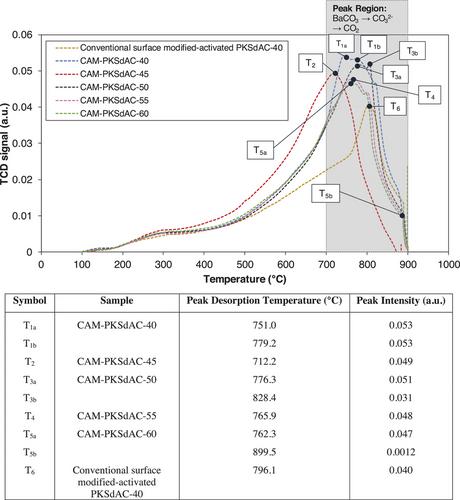下载PDF
{"title":"同时活性炭和表面改性棕榈仁壳衍生活性炭的燃烧后二氧化碳吸附作用","authors":"Jia Yen Lai, Lock Hei Ngu","doi":"10.1002/ghg.2274","DOIUrl":null,"url":null,"abstract":"<p>This research applied a concurrent activation and surface modification (CAM) process to synthesize palm kernel shell-derived activated carbon (PKSdAC) to obtain CO<sub>2</sub> affinity surface functionalization. The CAM process is a simplified activated carbon activation process that is cost-effective. The CAM process used in this study integrates sulphuric acid activation and barium chloride functionalization. The formation of barium sulphate is targeted to incorporate barium through a reduction process with carbon-containing material at elevated temperatures into PKSdAC to obtain basic metal surfaces functional group for chemical adsorption. The optimal temperature for CAM-PKSdAC CO<sub>2</sub> adsorption performance was at 40–60 °C, established through temperature-programmed desorption of CO<sub>2</sub> (TPD-CO<sub>2</sub>) analysis. The CAM-PKSdAC adsorption performance was tested using a lab-scale adsorption system. The bed CO<sub>2</sub> content was determined using gas chromatography coupled with a thermal conductivity detector (GC-TCD) by manual syringe injection. CAM-PKSdAC exhibited a high CO<sub>2</sub> adsorption capacity of 0.89 mmol g<sup>−1</sup> from TPD-CO<sub>2</sub>, and 1.91 mmol g<sup>−1</sup> from GC-TCD at 40 °C and 1 bar. It showed comparable CO<sub>2</sub> adsorption capacity to conventional surface modified-activated PKSdAC (1.96 mmol g<sup>−1</sup>) while higher than commercial and modified ACs (1.14–1.60 mmol g<sup>−1</sup>), but lower than potassium hydroxide modified ACs (1.81–2.10 mmol g<sup>−1</sup>) at 40 °C and 1 bar. Barium promoted chemisorption of CO<sub>2</sub> as supplementary reaction, which increases adsorption capacity. The non-linear Dubinin Radushkevich model strongly correlates with the experimental adsorption data for CAM-PKSdAC adsorption, indicating the physisorption process via micropore filling on CAM-PKSdAC. CAM-PKSdAC showed moderate reusability with negligible variation in adsorption capacity after 10 adsorption–desorption cycles. © 2024 Society of Chemical Industry and John Wiley & Sons, Ltd.</p>","PeriodicalId":12796,"journal":{"name":"Greenhouse Gases: Science and Technology","volume":"14 3","pages":"492-525"},"PeriodicalIF":2.7000,"publicationDate":"2024-04-21","publicationTypes":"Journal Article","fieldsOfStudy":null,"isOpenAccess":false,"openAccessPdf":"https://onlinelibrary.wiley.com/doi/epdf/10.1002/ghg.2274","citationCount":"0","resultStr":"{\"title\":\"Post-combustion carbon dioxide adsorption of concurrent activated and surface modified palm kernel shell-derived activated carbon\",\"authors\":\"Jia Yen Lai, Lock Hei Ngu\",\"doi\":\"10.1002/ghg.2274\",\"DOIUrl\":null,\"url\":null,\"abstract\":\"<p>This research applied a concurrent activation and surface modification (CAM) process to synthesize palm kernel shell-derived activated carbon (PKSdAC) to obtain CO<sub>2</sub> affinity surface functionalization. The CAM process is a simplified activated carbon activation process that is cost-effective. The CAM process used in this study integrates sulphuric acid activation and barium chloride functionalization. The formation of barium sulphate is targeted to incorporate barium through a reduction process with carbon-containing material at elevated temperatures into PKSdAC to obtain basic metal surfaces functional group for chemical adsorption. The optimal temperature for CAM-PKSdAC CO<sub>2</sub> adsorption performance was at 40–60 °C, established through temperature-programmed desorption of CO<sub>2</sub> (TPD-CO<sub>2</sub>) analysis. The CAM-PKSdAC adsorption performance was tested using a lab-scale adsorption system. The bed CO<sub>2</sub> content was determined using gas chromatography coupled with a thermal conductivity detector (GC-TCD) by manual syringe injection. CAM-PKSdAC exhibited a high CO<sub>2</sub> adsorption capacity of 0.89 mmol g<sup>−1</sup> from TPD-CO<sub>2</sub>, and 1.91 mmol g<sup>−1</sup> from GC-TCD at 40 °C and 1 bar. It showed comparable CO<sub>2</sub> adsorption capacity to conventional surface modified-activated PKSdAC (1.96 mmol g<sup>−1</sup>) while higher than commercial and modified ACs (1.14–1.60 mmol g<sup>−1</sup>), but lower than potassium hydroxide modified ACs (1.81–2.10 mmol g<sup>−1</sup>) at 40 °C and 1 bar. Barium promoted chemisorption of CO<sub>2</sub> as supplementary reaction, which increases adsorption capacity. The non-linear Dubinin Radushkevich model strongly correlates with the experimental adsorption data for CAM-PKSdAC adsorption, indicating the physisorption process via micropore filling on CAM-PKSdAC. CAM-PKSdAC showed moderate reusability with negligible variation in adsorption capacity after 10 adsorption–desorption cycles. © 2024 Society of Chemical Industry and John Wiley & Sons, Ltd.</p>\",\"PeriodicalId\":12796,\"journal\":{\"name\":\"Greenhouse Gases: Science and Technology\",\"volume\":\"14 3\",\"pages\":\"492-525\"},\"PeriodicalIF\":2.7000,\"publicationDate\":\"2024-04-21\",\"publicationTypes\":\"Journal Article\",\"fieldsOfStudy\":null,\"isOpenAccess\":false,\"openAccessPdf\":\"https://onlinelibrary.wiley.com/doi/epdf/10.1002/ghg.2274\",\"citationCount\":\"0\",\"resultStr\":null,\"platform\":\"Semanticscholar\",\"paperid\":null,\"PeriodicalName\":\"Greenhouse Gases: Science and Technology\",\"FirstCategoryId\":\"93\",\"ListUrlMain\":\"https://onlinelibrary.wiley.com/doi/10.1002/ghg.2274\",\"RegionNum\":4,\"RegionCategory\":\"环境科学与生态学\",\"ArticlePicture\":[],\"TitleCN\":null,\"AbstractTextCN\":null,\"PMCID\":null,\"EPubDate\":\"\",\"PubModel\":\"\",\"JCR\":\"Q3\",\"JCRName\":\"ENERGY & FUELS\",\"Score\":null,\"Total\":0}","platform":"Semanticscholar","paperid":null,"PeriodicalName":"Greenhouse Gases: Science and Technology","FirstCategoryId":"93","ListUrlMain":"https://onlinelibrary.wiley.com/doi/10.1002/ghg.2274","RegionNum":4,"RegionCategory":"环境科学与生态学","ArticlePicture":[],"TitleCN":null,"AbstractTextCN":null,"PMCID":null,"EPubDate":"","PubModel":"","JCR":"Q3","JCRName":"ENERGY & FUELS","Score":null,"Total":0}
引用次数: 0
引用
批量引用



